|
June 28, 2018 Tennessee Valley Derecho
|
| |
.PNG) |
| GOES-16 Infrared (IR) Satellite image around 12:45 PM CDT of the derecho as it moved into Northern Alabama. The brighter colors represent colder cloud tops and thus, stronger thunderstorms. |
| |
|
A significant damaging wind event occurred across the region on Thursday, June 28, 2018, from an intense complex of severe thunderstorms that moved through the Tennessee Valley, southward through the state of Alabama, and into the Gulf of America -- nearly 400 miles traversed! This MCS formed roughly along a weak frontal boundary stretching from Northwest Georgia into South Central Kentucky during the mid to late morning hours on June 28th. The mean flow around the eastern edge of a sprawling upper-ridge over the Southern Plains dictated this complex would drop south into the Alabama later in the day.
|
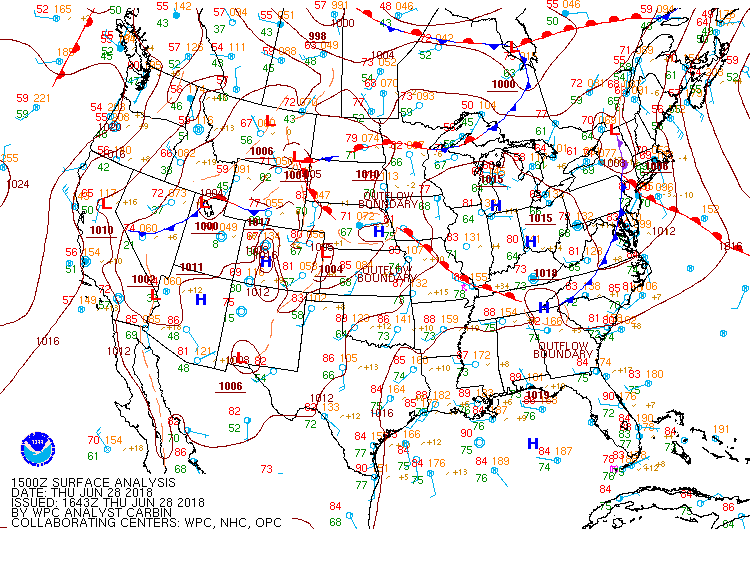 |
 |
| Surface Analysis at 10 AM CDT on June 28, 2018. |
Radar Loop From 10 AM to 4 PM CDT on June 28, 2018. |
|
| |
| Due to the moderate/high instability that developed across the region by midday, there was ample fuel for these storms to intensify as they moved southwest toward the Alabama/Tennessee state border. Severe thunderstorms within the complex produced widespread, intense wind damage across all of Southern Middle Tennessee and Northern Alabama. In fact, over 85 reports of damage were documented across our 14 counties -- most from downed trees and power lines. However, there was an area in eastern Madison County where some particularly, intense damage occurred, just north of Gurley (in the Killingsworth Cove community). A NWS damage survey concluded 100 mph straight-line winds occurred there, which caused some significant tree damage, as well as some structural damage to a few homes. |
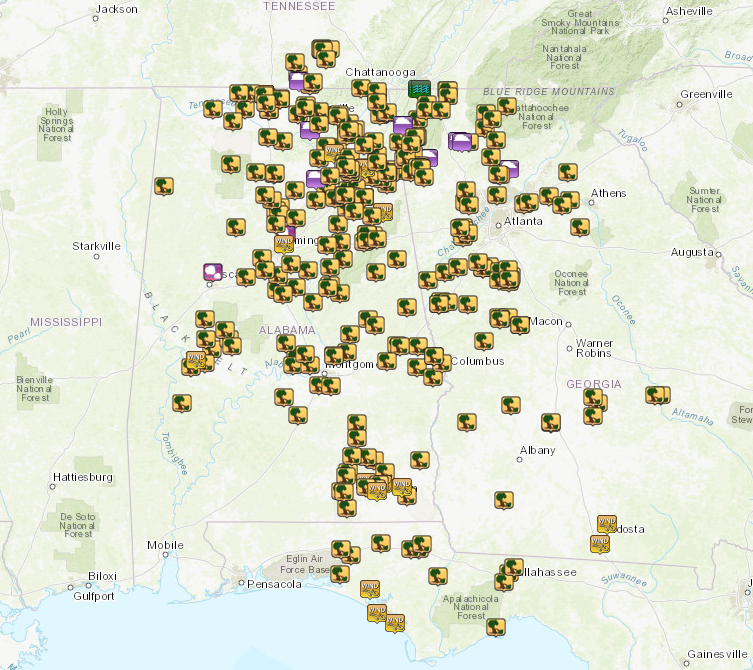 |
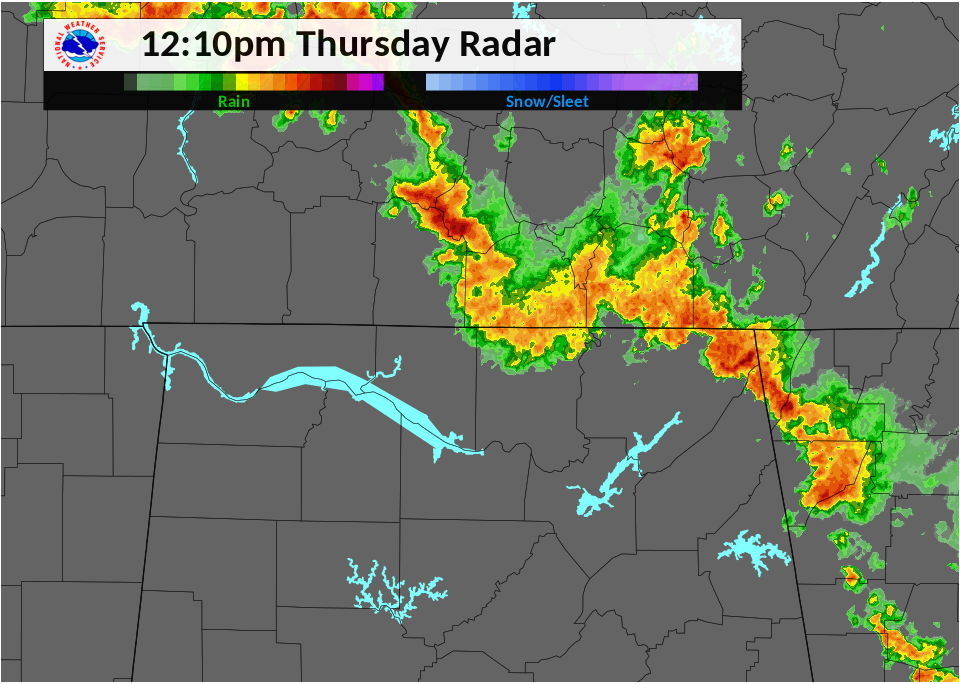 |
| The widespread nature of the wind damage reports across Alabama and Georgia can be seen in the map above. |
WSR 88-D (HTX) radar image of the storm complex as it moved in Gurley, producing the 100 mph straight-line wind damage. |
|
| |
| Additionally, these storms produced a tremendous amount of lightning which contributed to the widespread power outages observed. In fact, 231,000 customers were without power during the afternoon of June 28th (source: Alabama Power). These outages persisted well into the weekend in some rural areas across the state. |
| |
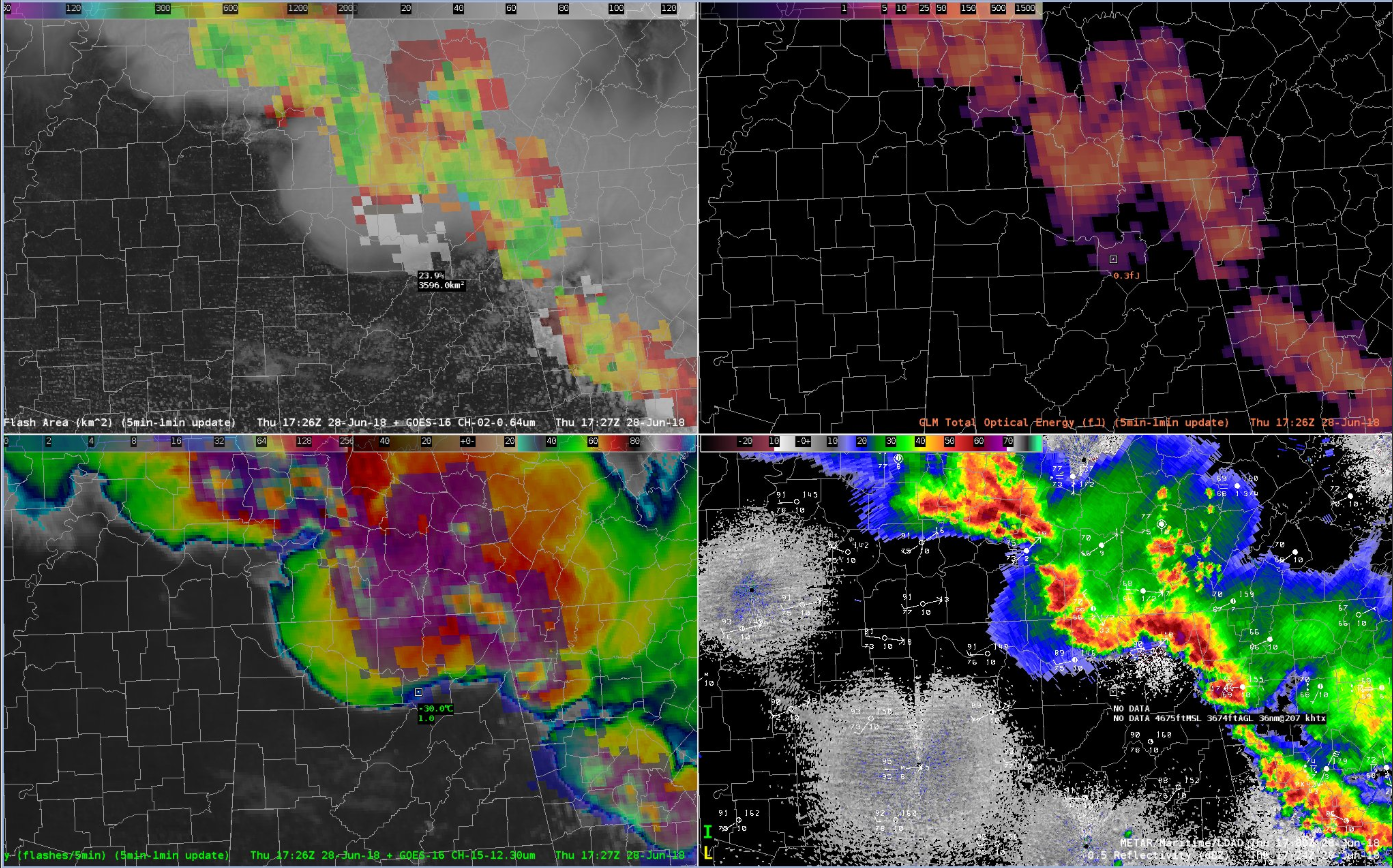 |
|
Geostationary Lightning Mapper (GLM) data observed during the June 28, 2018 Derecho in Northern Alabama. The GLM observes total lightning (i.e., both cloud-to-ground and intra-cloud flashes). Total lightning is tied to the strength of the thunderstorm and helps operational forecasters better determine which storms are most significant and the spatial area to which lightning may pose a threat. (Image: Jason Jordan and NASA SPoRT).
|
|
Survey Information
|
One pocket of wind along this line that moved south into Madison county was associated with a particularly strong bowing segment of this Derecho.
Location: Madison County, AL - Gurley Area
|
| Peak Wind |
100 MPH |
| Path Length (Statue Miles) |
0.78 Miles |
| Path Width (Maximum) |
350 Yards |
| Fatalities |
0 |
| Injuries |
0 |
| Start Date/End Date |
June 28th |
| Start Time/End Time |
12:15 PM CDT/1216 PM CDT |
|
Description:
Widespread tree damage was observed in the Killingsworth cover area of eastern Madison county. A wide (at least 300 yard) swath of trees was snapped, beginning at the top of the hill just west of Smith Lake, down the hillside across Boulder Trail Road, Southard Road, and Killingsworth Cove Road to the shore of the lake. The trees on the hillside were snapped, cleanly, and almost entirely in the same direction (Downhill) with a few exceptions. Several trees fell on homes along Killingsworth Cove Road. The swath of damage continued across the lake to JB Hawkins Road and Killingsworth Cove Road. The swath of daamge continued across the lake to JB Hawkins Road and Killingsworth Cover, but no further damage was observed or accessible east of this location. There did not appear to be a consistent, convergent pattern normally associated with a tornado. Instead, it fanned outward from an origin point on the hillside. Upon reviewing radar from KHTX (Hytop, AL), there is an area of enhanced velocity noted ahead of the main line of thunderstorms. The evidence mostly supports a channel of enhanced straight-line winds (possibly enhanced by the terrain), though a weak tornado or gustnado annot be completely ruled out. Note: The information in this statement is preliminary and subject to change pending final review of the event and publication in NWS Storm Data. |
|

Radar image at 1210 pm, as the bow was approaching Gurley.
|
| Back to the Top of the Page |
What is a Derecho?
|
You may have heard the National Weather Service has officially classified the June 28, 2018 damaging wind event as a derecho. A "Derecho" is a long-lived, rapidly moving line of intense thunderstorms that produces widespread damaging winds in a nearly continuous swath. This band of rapidly moving showers or thunderstorms may also be referred to a squall line, bow echo, or quasi-linear convective system. What makes a derecho such a unique event is the scope/distance that these storm complexes travel (at least 400 km or 240 miles) and the magnitude of widespread wind damage that occurs with them. Although a derecho can produce wind speeds similar to that of an EF-0 to EF-2 weak tornado, the damage typically occurs in one direction along a relatively straight swath. As a result, the term "straight-line wind damage" sometimes is used to describe derecho damage.
The word "derecho" was coined by Dr. Gustavus Hinrichs, a physics professor at the University of Iowa, in a paper published in the American Meteorological Journal in 1888. The term derecho derives from a Spanish word that can be interpreted as "straight ahead" or "direct" and was chosen to discriminate between wind damage caused by tornadoes, which have rotating flow, from straight-line winds. While the term was used in the meteorological community for a short time during the late nineteenth century, it disappeared from use for nearly 100 years until resurrected by severe weather meteorologists in the mid-1980s.
Source Information: NWS/SPC and the American Meteorological Society.
|
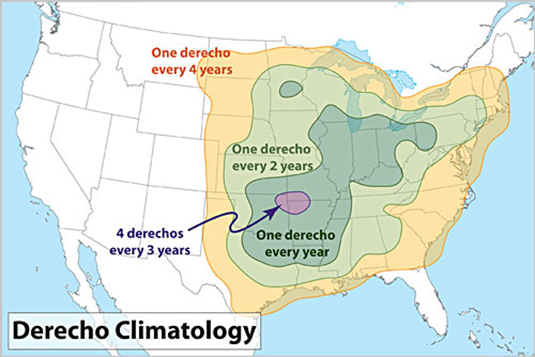 |
| A derecho is not unfamiliar weather event in the Tennessee Valley. In general one may occur every other year. However, they do occur less frequently than areas across the Great Plains, Midwest, and Ohio Valley. [Image: Steve Corfidi/SPC.] |
| |
| Back to the Top of the Page |
SPC Outlooks
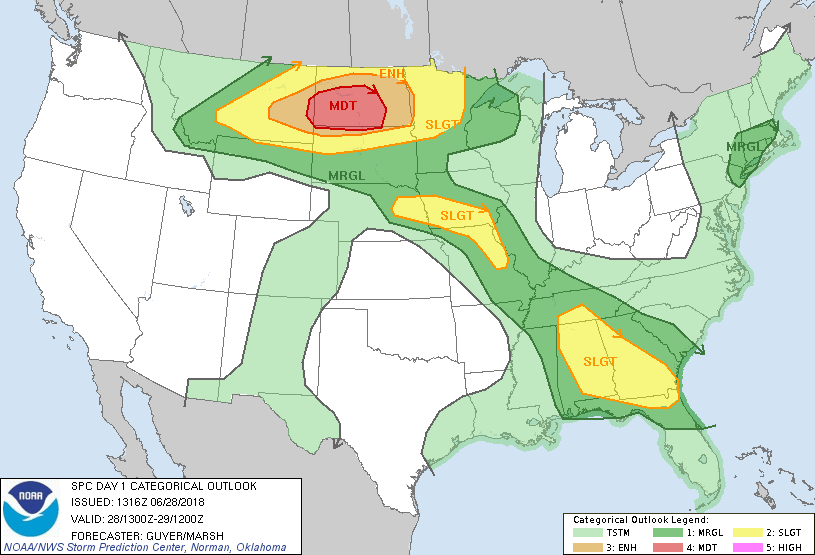
Day 1 Outlook
Issued am June 28th
|
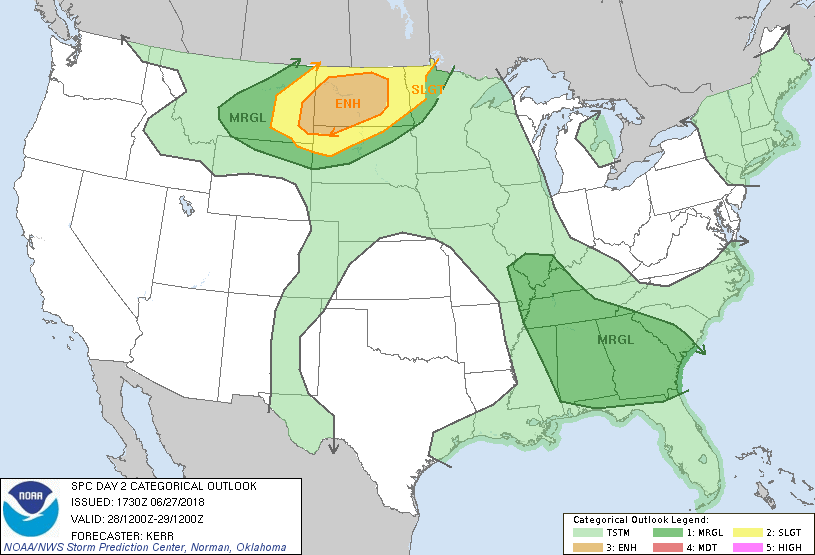
Day 2 Outlook
Issued m June 27th
|
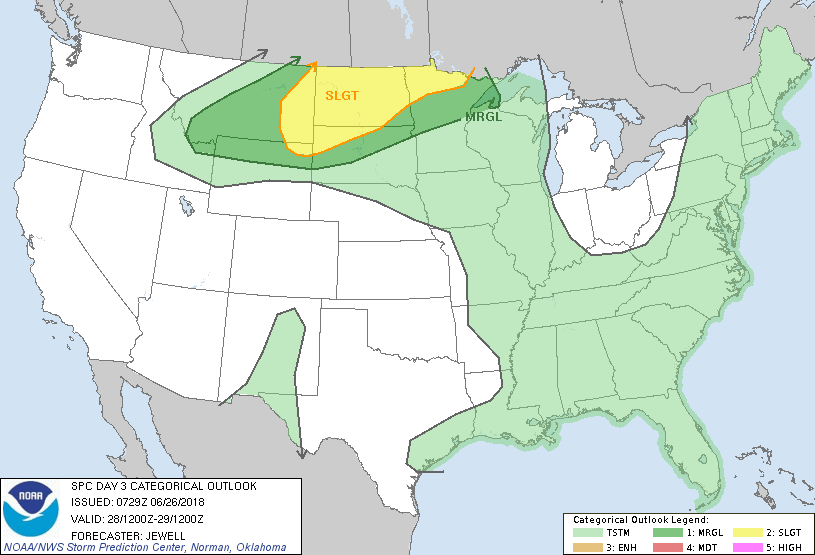
Day 3 Outlook
Issued am June 26th
|
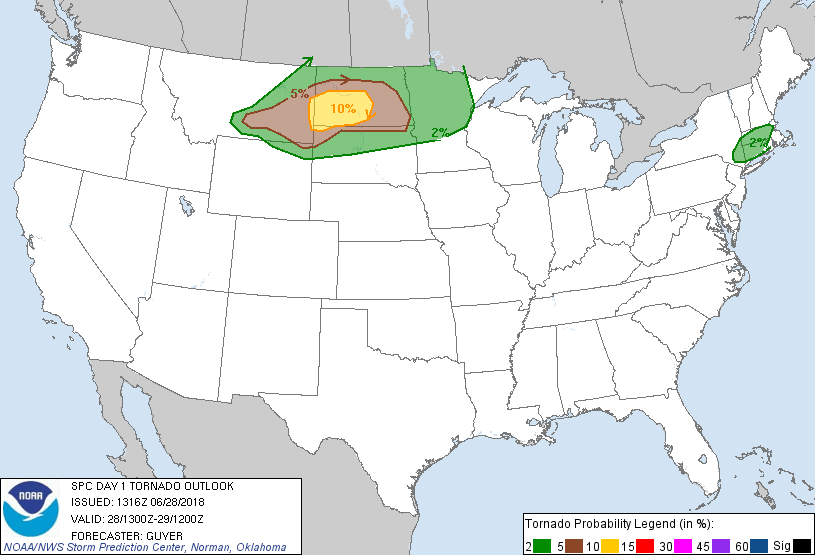
Day 1 Tornado Probability
Issued am June 28th
|

Day 1 Wind Probability
Issued m June 27th
|
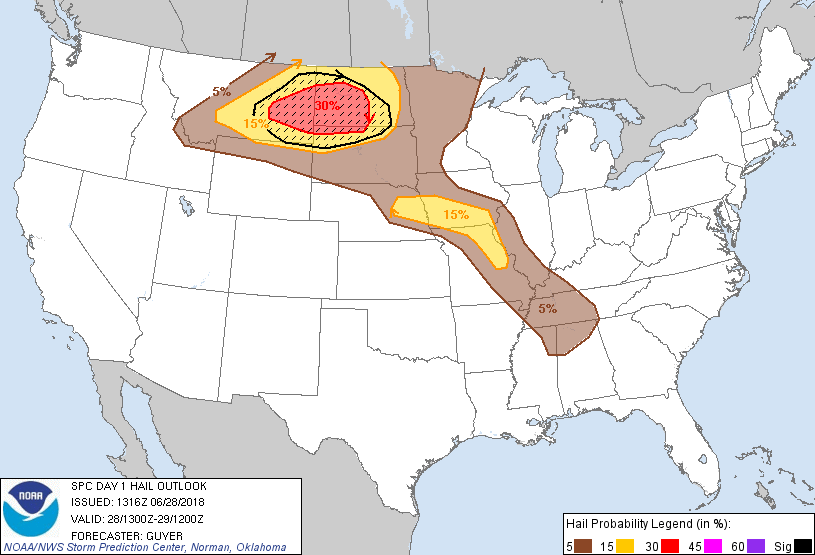
Day 1 Hail Probability
Issued am June 26th
|
| Back to the Top of the Page |
|